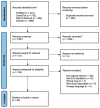Toxicity of Synthetic Cannabinoids in K2/Spice: A Systematic Review
- PMID: 37508922
- PMCID: PMC10377539
- DOI: 10.3390/brainsci13070990
Toxicity of Synthetic Cannabinoids in K2/Spice: A Systematic Review
Abstract
(1) Background: Synthetic cannabinoids (SCs) are emerging drugs of abuse sold as 'K2', 'K9' or 'Spice'. Evidence shows that using SCs products leads to greater health risks than cannabis. They have been associated with greater toxicity and higher addiction potential unrelated to the primary psychoactive component of marijuana, Δ9-tetrahydrocannabinol (Δ9-THC). Moreover, early cases of intoxication and death related to SCs highlight the inherent danger that may accompany the use of these substances. However, there is limited knowledge of the toxicology of Spice ingredients. This systematic review intends to analyze the toxicity of SCs compounds in Spice/K2 drugs. (2) Methods: Studies analyzing synthetic cannabinoid toxicity and dependence were included in the present review. We searched the PubMed database of the US National Library of Medicine, Google Scholar, CompTox Chemicals, and Web of Science up to May 2022. (3) Results: Sixty-four articles reporting the effects of synthetic cannabinoids in humans were included in our review. Ten original papers and fifty-four case studies were also included. Fourteen studies reported death associated with synthetic cannabinoid use, with AB-CHMINACA and MDMB-CHMICA being the main reported SCs. Tachycardia and seizures were the most common toxicity symptoms. The prevalence of neuropsychiatric symptoms was higher in third-generation SCs. (4) Conclusion: SCs may exhibit higher toxicity than THC and longer-lasting effects. Their use may be harmful, especially in people with epilepsy and schizophrenia, because of the increased risk of the precipitation of psychiatric and neurologic disorders. Compared to other drugs, SCs have a higher potential to trigger a convulsive crisis, a decline in consciousness, and hemodynamic changes. Therefore, it is crucial to clarify their potential harms and increase the availability of toxicology data in both clinical and research settings.
Keywords: AB-FUBINACA; AB-PINACA; ADB; AKB; AM; APICA; CHMICA; EAM; HU; JWH; K2; MAM; MDMB; PB; RCS; Spice; UR; WIN; XLR; synthetic cannabinoid.
Conflict of interest statement
The authors declare no conflict of interest.
Figures
Similar articles
-
Acute side effects after consumption of the new synthetic cannabinoids AB-CHMINACA and MDMB-CHMICA.Clin Toxicol (Phila). 2018 Jun;56(6):404-411. doi: 10.1080/15563650.2017.1393082. Epub 2017 Oct 26. Clin Toxicol (Phila). 2018. PMID: 29072524
-
Detection of the Synthetic Cannabinoids AB-CHMINACA, ADB-CHMINACA, MDMB-CHMICA, and 5F-MDMB-PINACA in Biological Matrices: A Systematic Review.Biology (Basel). 2022 May 23;11(5):796. doi: 10.3390/biology11050796. Biology (Basel). 2022. PMID: 35625524 Free PMC article. Review.
-
Assessment of types of synthetic cannabinoids in narcotic cases assessed by the Council of Forensic Medicine between 2011-2015, Ankara, Turkey.Forensic Sci Int. 2017 Nov;280:124-129. doi: 10.1016/j.forsciint.2017.09.017. Epub 2017 Oct 4. Forensic Sci Int. 2017. PMID: 29028489
-
Identification of synthetic cannabinoids that were seized, consumed, or associated with deaths in Kuwait in 2018 using GC-MS and LC-MS-MS analysis.Forensic Sci Int. 2019 Oct;303:109960. doi: 10.1016/j.forsciint.2019.109960. Epub 2019 Sep 13. Forensic Sci Int. 2019. PMID: 31550599
-
Distinct pharmacology and metabolism of K2 synthetic cannabinoids compared to Δ(9)-THC: mechanism underlying greater toxicity?Life Sci. 2014 Feb 27;97(1):45-54. doi: 10.1016/j.lfs.2013.09.017. Epub 2013 Sep 29. Life Sci. 2014. PMID: 24084047 Free PMC article. Review.
Cited by
-
Prevalence and patterns of substance use in West Africa: A systematic review and meta-analysis.PLOS Glob Public Health. 2024 Dec 31;4(12):e0004019. doi: 10.1371/journal.pgph.0004019. eCollection 2024. PLOS Glob Public Health. 2024. PMID: 39739732 Free PMC article.
-
Easy Availability of Marijuana and Other Cannabis-Derived Products: What is the Missouri Poison Center Seeing?Mo Med. 2024 Sep-Oct;121(5):340-344. Mo Med. 2024. PMID: 39421471 Free PMC article. No abstract available.
-
Fatal Overdose with the Cannabinoid Receptor Agonists MDMB-4en-PINACA and 4F-ABUTINACA: A Case Report and Review of the Literature.Toxics. 2023 Aug 5;11(8):673. doi: 10.3390/toxics11080673. Toxics. 2023. PMID: 37624178 Free PMC article.
-
New Psychoactive Substances Toxicity: A Systematic Review of Acute and Chronic Psychiatric Effects.Int J Mol Sci. 2024 Aug 31;25(17):9484. doi: 10.3390/ijms25179484. Int J Mol Sci. 2024. PMID: 39273431 Free PMC article.
-
Cannabis Use Variations and Myocardial Infarction: A Systematic Review.J Clin Med. 2024 Sep 22;13(18):5620. doi: 10.3390/jcm13185620. J Clin Med. 2024. PMID: 39337107 Free PMC article. Review.
References
-
- United Nations Office on Drugs and Crime World Drug Report 2020 (Sales No. E. 20) [(accessed on 20 December 2022)]. Available online: https://wdr.unodc.org/wdr2020/index2020.html.
Publication types
LinkOut - more resources
Full Text Sources
Miscellaneous



